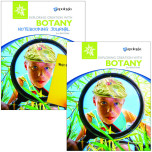We use cookies to make your experience better. To comply with the new e-Privacy directive, we need to ask for your consent to set the cookies. Learn more.
Newly revised, this updated edition of Botany offers expanded content and activities. If you are familiar with the 1st edition, the first thing you will notice about the updated edition is the improved layout and graphics. Opening the textbook, the vibrant illustrations and updated hands-on activities formatting are eye catching. Most of the lesson content has been rewritten, giving the text a less casual or chatty feel, while remaining clear and understandable for children. The new edition offers 14 chapters covering an introduction to botany, seeds, flowers, pollination, fruits, leaves, as well as the roots and stems of plants. Children also learn about food production, with one lesson dedicated to teaching children about gardening, including how to build a raised garden. Additionally, the new edition introduces mycology (the study of fungi). Hands-on activities remain essential to the course. There is also a greater focus in this new edition on creating a Charlotte Mason inspired nature journal. Families may choose to purchase the updated Notebooking Journal to create a written record of work and activities. Young students may also elect to create their own journal. Botany is designed to be done 2 days per week, approximately one hour each day. Lessons with outdoor adventures or activities may take longer to complete. The 2nd edition Notebooking Journal is not compatible with the 1st edition.
A magnifying glass is recommended, along with other common household or easy-to-find local items. Contact us for an updated list of recommended supplies. Textbook contains 14 lessons, the activity supply list, and an answer key. 237 pgs, hc.
The Notebooking Journal is a wonderful way to reinforce learning through documenting observations, recording thoughts, and reviewing content through the hands-on booklets they create. Colorful pages, space to record observations and answer questions, mini-books, plus coloring pages are all included for engaging the young learner. Notebooking Journals also include a daily schedule based on the 2 day per week/one hour per lesson recommendation. Non-reproducible, each child will need their own Notebooking Journal. Spiral bound.
A Lab Kit packaged by Nature’s Workshop is a convenient way to purchase many of the materials that you will need for labs and activities. Most activities require only household items, so you can also gather them yourself if you prefer. ~ Deanne











